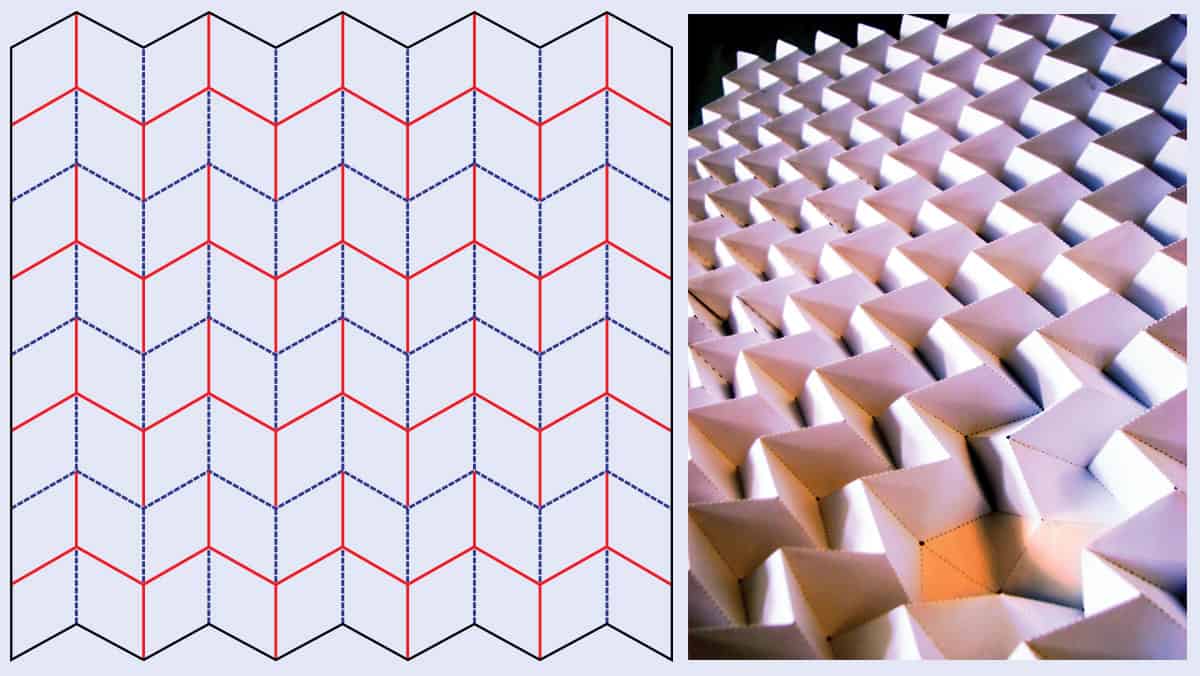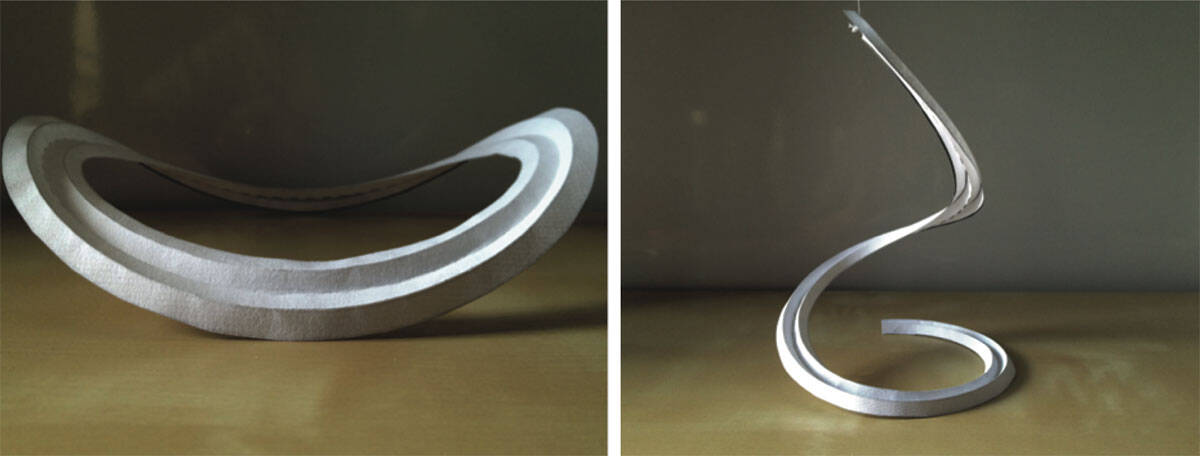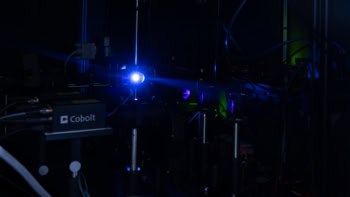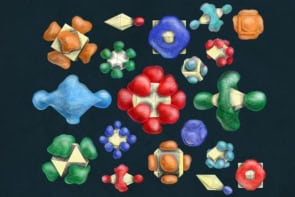From solar panels to nanoscale machines, physics applications of origami and kirigami have surged in recent years. Simon Perks reports

We’ve all admired the delicate butterflies, cranes and flowers created by those who have mastered the art of paper-folding. But far from being a decorative curiosity, origami techniques are increasingly being used to solve real-world problems in physics and beyond. From solar panels and telescope lenses to designer materials and nanoscale machines, the ability to create 3D objects from 2D materials has energized physicists and created a new realm of interdisciplinary research.
The term “origami” comes from the Japanese words “ori”, meaning folding, and “kami”, meaning paper. However, the art of folding paper to create sculptures and shapes arose independently over the course of the last millennium in Europe, China and Japan. In Eastern cultures, origami representations played a symbolic role in wedding and funeral ceremonies, while in the West they were more a dinner-time novelty for the social elite. In the 1950s, though, the work of a new generation of origami artists inspired a renaissance of the craft, which became an art form in its own right.
The aim of origami is to turn a flat piece of paper into a 3D sculpture or model by folding it in different ways. The most common origami techniques are the “valley” fold, where the paper is folded upwards into a 3D “V” shape with a crease at the bottom, and the “mountain” fold, where the crease is at the top and the paper is folded downwards in a 3D “Λ” shape. Most other techniques in origami are a variation on – or combinations of – these two folds.
Almost any flat material can be used for origami, provided it holds a crease. Origami artists generally use specialist paper for their creations, but materials such as cloth, money, leather, metal, leaves, pasta and even tortillas can also be used. One thing that origami purists frown on is anything that involves cutting the paper or other material used in their creations. However, a variation of the craft has arisen in which folding and cutting are combined to produce delicate – and usually symmetrical – sculptures, patterns and shapes. This is known as kirigami, from the Japanese “kiru” meaning to cut. What both origami and kirigami forbid, however, is any sticking or taping of the materials used. Structure and stability are provided solely by the folding and cutting of the material by the artist.
More than just paper cranes
Origami’s ever-growing role in science lies in the fact that both it and kirigami can create 3D structures from a flat, 2D material, giving researchers ways of packing large sheets of material into small spaces. One of the most common techniques for achieving this is the “Miura-ori” pattern (see box below), which combines valley and mountain folds to allow a flat sheet to be folded into a much smaller volume using just a compressional force in the plane of the sheet – and likewise for the compressed sheet to be unfolded with minimal force. This approach was used, for example, in 1995 to unfold a solar panel on a Japanese satellite called the Space Flyer Unit.
Engineers at the Lawrence Livermore National Laboratory in the US, working with American physicist and origami master Robert Lang, used a more complex folding pattern to develop a prototype 5 m-diameter space-telescope lens that could be folded into a cylinder for launch and then unfolded once in orbit. (Sadly, the 100 m version was never built.) And engineers Zhong You and Kaori Kuribayashi from the University of Oxford, UK, used an origami fold pattern called the “waterbomb” to develop a medical stent that can be inserted in folded form into a clogged artery and then deployed to open up the blood vessel and restore blood flow.
The principles of origami mean that when paper or any other suitable material is folded, its mechanical properties are determined by the specific pattern of the folds. Physicists can therefore use origami fold patterns to design materials with the properties that they need. And it is in this area of “designer mechanics” that the really exciting developments are happening.
The Miura-ori pattern

The “Miura-ori” pattern – developed by astrophysicist Koryo Miura, after whom it is named – combines valley and mountain folds to allow a flat sheet to be folded into a much smaller area. One unusual physical property it gives a material is that if you pull on opposite ends, the material becomes wider in a perpendicular direction, while if you compress them, the material becomes more narrow.
Initially designed for use with solar panels on spacecraft, Miura-ori is also gaining popularity as a way of folding maps. This is because the folding pattern, using parallelograms instead of the usual squares or rectangles, places less stress on the folds and makes them less likely to tear or wear out.
In a paper last year in Science (345 647), a team led by physicist Jesse Silverberg at Cornell University explored the Miura-ori tessellation as a metamaterial design. The group found, for example, that the compressive modulus of the structure can be tuned by adding a “pop-through defect”, which can be achieved on the paper version by pushing one of the vertices so that it pops out in the other direction. Such “lattice defects” can be used to create analogues of crystallographic structures such as vacancies, dislocations and grain boundaries.
To see the effect for yourself, cut out the template above along the black line, crease all the solid red lines so they form “mountain folds” that point up off the page, crease all the dashed blue lines so they form “valley folds” that point down into the page. You should be able to collapse all the creases in one simple movement so that it folds flat, or squeeze it from the sides to collapse it into a much smaller area.
A focus on folding
So what’s caused the recent surge of interest in origami in physics and engineering? There are three main reasons, says Itai Cohen, a complex-matter physicist at Cornell University in the US. First, we’re learning more about how origami works. “The mathematics of origami have recently undergone a revolution,” he says. This means that we now know more about how to make the fold patterns we want. Second, the development of laser cutters and 3D printing makes it easier to generate these patterns. And third, improved polymer fabrication methods mean that we can create microscale polymers with
responsive properties.

Another reason for the increased focus on origami by physicists is that origami is scale-invariant. In other words, because the principles of origami are geometrical in nature they can be applied at the largest or smallest scales imaginable – and the geometry will still work. This property is of particular interest for physicists working at the smaller end of the size spectrum. “We can make shapes with almost atomistic resolution,” says biophysicist Ulrich Keyser at the University of Cambridge, UK, who uses origami techniques to create DNA structures. “It’s a huge advantage.”
This approach is not without its challenges, mainly because folding paper is not as simple as you might think. Origami is complicated and researchers often use simplifying assumptions, such as perfect hinges and rigid facets, that do not hold in reality. “The basic theory is a good first step,” says Cohen, “but you need to do all this extra stuff to figure out what is going on in the experiment.”
Another difficulty, says Paul McEuen, a nanoscale physicist at Cornell, is that we do not yet have a thorough understanding of how origami systems will behave when pulled or compressed. For this, we need both a better understanding of origami behaviour and improved design tools. And even when we do know how particular fold patterns work, it is not always straightforward to create them because some materials are harder to work with than others.
Materials need a high degree of homogeneity if they are to be useful for origami or kirigami, otherwise, it can be difficult to predict how they will behave
A general rule of thumb is that origami techniques work well on materials that are thin, but not so thin that they are invisible to the naked eye. Thicker sheets tend to buckle or deform when folded, while materials behave entirely differently on the nanoscale. “A graphene sheet is difficult to crease,” McEuen adds. “It just pops back into shape.” Furthermore, says chemical engineer Nick Kotov at the University of Michigan in the US, materials need a high degree of homogeneity if they are to be useful for origami or kirigami. Otherwise, it can be difficult to predict how they will behave when folded or compressed.
Research priorities
For such a relatively new discipline, current research into origami and kirigami techniques is broad. For some scientists, the focus is on understanding more about how such techniques work with different materials: Christian Santangelo, a condensed-matter physicist at the University of Massachusetts Amherst in the US, for example, is exploring the relationship between the geometry of materials and their mechanical properties. Others, such as Cohen, are trying to understand the basic design principles to tune the mechanical properties of real-world (as opposed to ideal) materials, in which, for example, a fold causes a slight deformation and uses up a tiny bit of the material. And You, who brought us the origami stent, is currently developing approaches to folding thicker materials.
Researchers are also using origami and kirigami to build things. “We’re extending origami to the very small scale,” says Cohen. “We’re trying to fold graphene, to realize the 2D-to-3D paradigm in the thinnest materials that are available – or will ever be available, really.” In doing so, Cohen hopes to be able to create tiny devices that can measure key information about their environment and report back the results. McEuen, meanwhile, is seeking to build and activate ever more complex structures including the world’s “softest” electronics, which could be stretched across a cell to record when neurons fire.

As for Kotov, he wants to overcome the lack of homogeneity in materials used for origami and kirigami by using layer-by-layer assembly to produce composite structures based on graphene and carbon nanotubes. Kotov is especially interested in materials requiring a combination of properties, such as conductivity and “stretchability”. While there is usually a trade-off between the two, Kotov has already succeeded in making electrically conductive composite sheets more elastic – increasing their strain from 4% to 370% without affecting their conductivity.
And it’s not just graphene. Keyser has used origami techniques to create self-assembly DNA structures and is now exploring the physics of membrane transport and the role that new membrane proteins could play in shaping biological membranes at the nanoscale. His longer-term aim, though, is to use origami to build DNA-based protein replacements. If successful, this “nanomedicine” could provide a valuable new weapon to help combat genetic diseases.
A bright future
It appears that origami and kirigami techniques can be applied to many different areas of research. But is this just an interesting novelty or the start of something more profound? Cohen is cautious. “It depends,” he says, “on whether we can move beyond the exploratory phase to identifying a particular problem that is worthy of solution.” Santangelo is more confident, explaining that “people are going to start making real things using origami”. But McEuen is outright optimistic. “I think you’ll see it emerge as a major paradigm for how to build complex structures,” he says. “It will be the standard way of building stuff.”
For Kotov, the future of origami and kirigami will be about how small we can make the folds and cuts, potentially taking us from microscale to nanoscale fabrication, which could lead to a new generation of materials for electronics. “Stretchable electronics is clearly one of the strong fields of application for kirigami composites,” he says. “The trends for electronics are for them to be conformable, biomimetic and human friendly. But the materials are the bottleneck here.” Kotov also expects new developments in optics, once origami and kirigami get down to the scale of the wavelength of visible light.
Further developments are likely to come from the way in which origami and kirigami are not only bringing together researchers from different fields but artists, architects and designers, too. Santangelo agrees. “It’s much more interdisciplinary than anything else I’ve done,” he says.
And although we should not overlook origami’s aesthetic appeal, its fun and its beauty, the application of origami and kirigami to modern problems is a serious endeavour. It is one that could change forever how we build things in physics.



